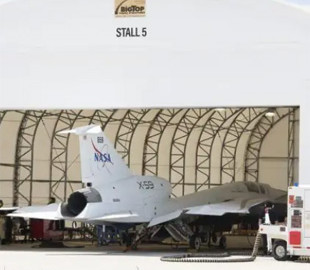
During the last week, engineers of the NASA X-59 Quest program (Quiet SuperSonic Technology, “Quiet supersonic technology”) have been conducting test runs of the aircraft's engines at the Lockheed Martin Skunk Works. The tests are carried out in stages. Last time, engineers ran the X-59's engines at low speeds without ignition to check for leaks and make sure the plane's various systems were working together. Now the X-59 team refueled the aircraft and tested the engine at low power.
“The first phase of engine testing was actually a warm-up to make sure everything was working as it should before starting the engine, – said X-59 Chief Engineer Jay Brandon. – Then we moved on to actually starting the engine for the first time. This took the engine out of the conservation mode it had been in since it was installed on the aircraft. This was the first check to make sure it was working properly and that all the systems it affected – hydraulics, electrical system, environmental control systems, etc. – are working”.
The X-59 is designed to fly at a cruising speed of Mach 1.4 and an altitude of 16.7 km. The aircraft is equipped with a modified F414-GE-100 jet engine manufactured by General Electric. The F414 engine family is often used in military aviation, in particular in some versions of Boeing's F/A-18 Super Hornet fighter.
200% Deposit Bonus up to €3,000 180% First Deposit Bonus up to $20,000The X-59 was designed to fly faster than the speed of sound, but with a much quieter process of breaking the sound barrier. Currently, supersonic flights over land at a certain distance in the US are banned by the Federal Aviation Administration. And NASA hopes that the X-59 will be able to prove that supersonic flight is possible without creating deafening noise. If the goal is achieved, domestic flight times could be halved. This will be useful not only for commercial air travel, but also during disaster relief or medical transport.
To reduce the volume of sound waves, the X-59 uses a unique geometry, including an elongated, beak-like nose that takes up 11.5m of the aircraft's overall length of 30m. Instead of a loud sound, according to NASA, the aircraft should emit a soft « “knock” when it overcomes the sound barrier. It's like a person closing a car door outside, and you hear it indoors.
Due to the extended nose, X-59 pilots will have limited forward visibility. So it should compensate for the unique "external review system" (eXternal Vision System, or XVS), consisting of a camera connected to a screen mounted in the cockpit, which offers pilots the ability to see what is in front of them using augmented reality technology.
On in the next phase of testing, data will be entered into the aircraft's computer systems for both normal and malfunctioning conditions to see how the aircraft reacts. After that, the X-59 will undergo a “departure” to the runway to test how its control surfaces, brakes and engine work while on the ground. The date of the first flight has not yet been set, but during it engineers will collect data about the sounds that people will hear and how the public on the ground perceives and reacts to the noise it makes.

